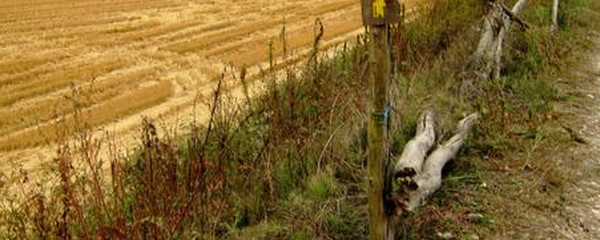Navigation

unmissverständliche Wegweiser kurz nach Vercelli
We will be hiking in rice plantations for the whole day, plantations structured by a system of irrigation channels serving for inflow and outflow of water. A multitude of sluices support controlling the best level of water for each phase of growth. It is hard to imagine how people at the time could cross this region before roads, bridges and dams were built here. Once harvesting in summer is completed, maintenance work in the fields begins, because vegetation would fill the channels immediately, and would thereby disable their function.

abgeerntete Reisfelder bei Vercelli
When leaving Vercelli, we will cross the river Sèsia, a northern Po afflux who has its source on Italian territory close to the Swiss border. Palestro is the only agglomeration on our hike today. Its church «San Martino di Tours» originally was a roman church, before it was reconstructed during the 16th century. Arriving at Robbio, we will find the city center around the piazza Dante Alighieri.
Note(s)
The «Via Francigena» is one of the 3 main christian pilgrimage trails of the Middle Ages, the main axis leading from Canterbury to Rome. This documentation currently covers the most frequented section from Lausanne to Rome.
Anmerkungen
Die «Via Francigena» ist einer der 3 christlichen Pilgerwege des Mittelalters, dessen Hauptachse von Canterbury in England nach Rom führt. Diese Dokumentation umfasst vorerst den Abschnitt von Pontarlier nach Rom.
Tipp des Autors
Die Etappen sind in dieser Dokumentation Vorschläge, die jeder Pilger seinen Wünschen anpassen kann. die technischen Daten betreffen aber immer die Annahme, diese Etappen würden jeweils an einem Tag absolviert.
Orte entlang des Weges
Vercelli - Roggia - Fiume Sèsia - Piemonte/Lombardia - Crocettone - Palestro - Cascina Sant'Anna - Cascina Bosco - Biraga - Robbio









